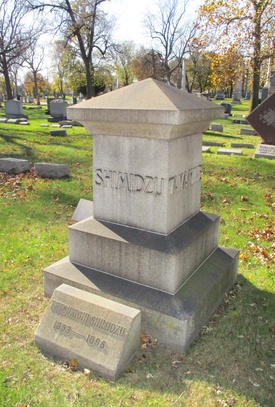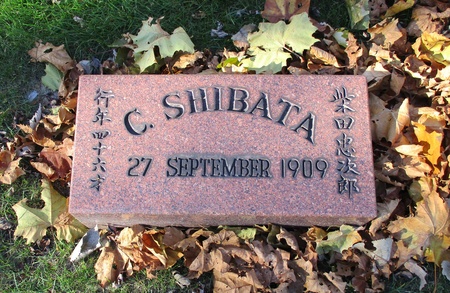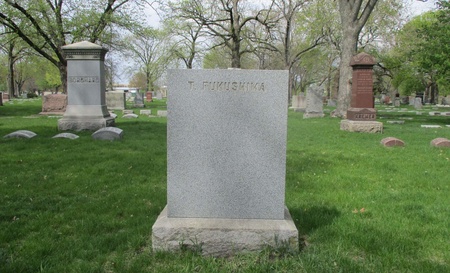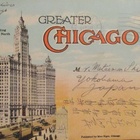The establishment of the Japanese cemetery in Chicago was the result of the efforts of the Japanese Mutual Aid Association, which was established in January 1935. The Mutual Aid Association was originally established with the objective of collecting 50-cent membership fees from over a hundred members, and to provide medical and hospital care when members became ill, as well as funeral and death procedures when members died. At the same time, from the time of its establishment, the Association also began a campaign to collect donations of about $1,000 from compatriots in order to purchase a communal cemetery and secure basic funds.
At the time, it was difficult for any cemetery in Chicago to sell land to Japanese people. However, in March 1935, two months after its establishment, the Mutual Aid Society was able to secure a 200-foot square plot in a corner of Montrose Cemetery in the north part of Chicago for $600. It paid $450 for the grave site and $150 for permanent cemetery arrangement fees. From then on, when Japanese people died in Chicago, they were buried in the Japanese section of Montrose Cemetery.
So what was it like before 1935? At that time, Japanese people lived all over Chicago, and after they died, they were buried in cemeteries all over the city. The cemetery that is mentioned most frequently in the documents is Oakwood Cemetery on the south side of Chicago. It is still unclear why the Japanese liked Oakwood Cemetery so much.
The first Japanese person to leave a record at Oakwood Cemetery was Shimizu Tekichi, a native of Gifu Prefecture. Shimizu was invited by Takamine Jokichi, who came to Chicago in 1890 and started a brewery, and came to America in 1892 at the age of 30. Takamine was Shimizu's senior at university, and served as his research assistant when Takamine was at the Department of Agriculture and Commerce. Perhaps because of this relationship, Shimizu obtained a passport on the pretext of academic research, and came to Chicago and then to Peoria in central Illinois.
However, just four years after arriving in America, in May 1896, Shimizu died of pulmonary tuberculosis, and his funeral was held at Takamine's home (6641 Woodlawn Avenue, Chicago). It is said that Shimizu's remains were brought back to Japan by Takamine's other assistant, the master brewer Fujiki Kosuke, when he returned to Japan in the summer of 1896. Shimizu's name engraved on the impressive tombstone is living proof that Shimizu Tekkichi set foot in Chicago, even if only for a short time.
Another person who left a brand new headstone in Oakwood Cemetery is Chujiro Shibata, who ran a brothel in Chicago and died in September 1909. When his granddaughter, singer Hamako Watanabe, visited his grave in 1950 after the war, she found a new headstone, perhaps.
Takeji Fukushima's grave is located in Rose Hill Cemetery in the north part of Chicago. He shares his gravestone with the Cox family, with Fukushima's name engraved on the east side and Cox's on the west side. However, the relationship between Fukushima and the Cox family is unclear. It is a mysterious gravestone that does not contain any information on the birth or death years of not only Fukushima, but also the three members of the Cox family buried there.
Fukushima was from Kagoshima and worked as a middle school principal in Tokyo, but he wanted to make a name for himself on the American continent, so he went to the United States in 1890. There is a record that he enrolled in the junior class of the law school at Washington University in St. Louis in the fall of 1891. However, it seems that around 1893, when the Columbian Exposition was held in Chicago, he began giving lectures on Japan under the title of professor. After touring the United States giving lectures for nearly 20 years, he died in Virginia on December 27, 1910. No one knows why Fukushima's grave is in Chicago, and why he borrows the tombstone of the Cox family.
In fact, only a very limited number of people are lucky enough to have a gravestone with their name engraved on it. Michitaro Ogawa, who spent more than 60 years in Chicagoland, from his arrival in the United States in 1871 until his death in 1938, is buried in Forest Home Cemetery, a western suburb of Chicago, but he has no gravestone. Many people were cremated in the cemetery and buried in a section of the cemetery that resembles an abandoned graveyard.
Ichiro Matsuo is one of those buried in a section without a gravestone, like an abandoned cemetery. Matsuo, who was born in Nagasaki, came to Chicago in 1893, perhaps to see the Columbian Exposition. He was 29 years old. After that, he attended art school and painted Japanese paintings, which were sometimes featured in newspapers.
What is interesting is that Matsuo was a Catholic, with the baptismal name Nicholas, which is unusual for a Japanese person. In 1897, he married Saito Ginko at St. Michael's Church in Chicago, where she was also baptized as a Catholic and took the name Maria. Matsuo lived in Chicago for over 40 years, and was buried in May 1938 in the Catholic Mount Carmel Cemetery in the suburbs of Chicago. The section of the cemetery that resembles an abandoned cemetery is not very well maintained, and when I visited in early spring, there was a thin layer of weeds growing there.
Another interesting figure is Shigeaki Suzuki, who is buried under the Press Club tombstone in Mount Hope Cemetery on the south side of Chicago.
Suzuki came to Chicago around 1892, helped exhibit and sell Japanese goods at the Columbian Exposition, and became very popular as a lecturer introducing Japanese culture. However, it is not clear how he made a living. Suzuki, who disliked contact with Japanese people, lived at the Press Club, one of Chicago's famous clubs, as the only Japanese member. When he died in Texas in May 1915, he was buried in the Press Club cemetery lot with white members, in accordance with the club's rules. Is it an exaggeration to say that Suzuki Shigeo was the only Japanese person in the whole of America to be buried in the same grave as white people at that time?
The person I imagine to be the happiest Japanese person to die in Chicago was Masakichi Yakura. Born in Kobe in 1883, Yakura joined the U.S. Navy in Hawaii in 1905 and served in World War I in July 1917, receiving the Mexican Campaign Medal.
During that time, he married Belle, a black woman from Arkansas who worked for the same boss. The boss thought the marriage was undesirable for the Navy and transferred Yakla to a different boss. Nevertheless, Yakla continued to perform well as a steward and was promoted until he was discharged in Illinois in 1921. After his discharge, he ran a restaurant in Waukegan, a town north of Chicago, and died in January 1956.
Yakura applied for citizenship during his lifetime, but unfortunately it was rejected for reasons unknown.
Yakla's grave is in Warren Cemetery in the town of Gurnee, near Waukegan.
After Yakla's death, Mrs. Genora Payne, who was thought to have been a close friend of Yakla's, applied to the government many times for a veteran's gravestone for Yakla, who had no gravestone, and was granted a year later. Yakla and his wife now rest side by side. Yakla's gravestone has a blue mark indicating that he was a veteran. There were probably many Japanese people in Chicago before the war, who were overwhelmingly single men, who died alone without anyone to look after them. Yakla's grave had a smile on its surface that I had never seen before.
The Japanese in Chicago are unknown warriors who barely feature in the conventional history of Japanese people in America, which has been centered on Hawaii and the West Coast. Even though they may be unknown, they are people who lived their lives to the fullest in the time they were given in Chicago.
© 2023 Takako Day












